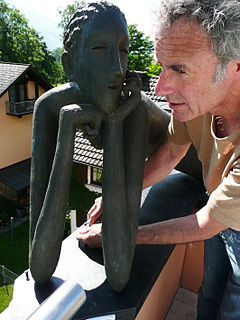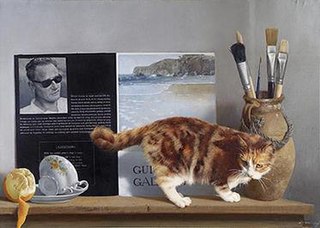Camille SouterHRHA is an Irish abstract and landscape artist. She lives and works on Achill Island and has been an elected member of Aosdána since 1981.

Lucian Michael Freud was a British painter and draughtsman, specialising in figurative art, and is known as one of the foremost 20th-century English portraitists. He was born in Berlin, the son of Jewish architect Ernst L. Freud and the grandson of Sigmund Freud. Freud got his first name "Lucian" from his mother in memory of the ancient writer Lucian of Samosata. His family moved to England in 1933 to escape the rise of Nazism. From 1942 to 1943 he attended Goldsmiths College, London. He served at sea with the British Merchant Navy during the Second World War.

The Scottish Colourists were a group of four painters, three from Edinburgh, whose Post-Impressionist work, though not universally recognised initially, came to have a formative influence on contemporary Scottish art and culture. They four artists, Francis Cadell, John Duncan Fergusson, Leslie Hunter and Samuel Peploe, were prolific painters spanning the turn of the twentieth century until the beginnings of World War II. While now banded as one group with a collective achievement and a common sense of British identity, it is a misnomer to believe their artwork or their painterly careers were heterogeneous.

The history of Irish art starts around 3200 BC with Neolithic stone carvings at the Newgrange megalithic tomb, part of the Brú na Bóinne complex which still stands today, County Meath. In early-Bronze Age Ireland there is evidence of Beaker culture and a widespread metalworking. Trade-links with Britain and Northern Europe introduced La Tène culture and Celtic art to Ireland by about 300 BC, but while these styles later changed or disappeared under the Roman subjugation, Ireland was left alone to develop Celtic designs: notably Celtic crosses, spiral designs, and the intricate interlaced patterns of Celtic knotwork.
Paul Henry was an Irish artist noted for depicting the West of Ireland landscape in a spare post-impressionist style.

Sir John Lavery was an Irish painter best known for his portraits and wartime depictions.

Sir Michael Craig-Martin is an Irish-born contemporary conceptual artist and painter. He is known for fostering and adopting the Young British Artists, many of whom he taught, and for his conceptual artwork, An Oak Tree. He is Emeritus Professor of Fine Art at Goldsmiths. His memoir and advice for the aspiring artist, On Being An Artist, was published by London-based publisher Art / Books in April 2015.

Clitheroe Royal Grammar School is a co-educational grammar school in the town of Clitheroe in Lancashire, England, formerly an all-boys school. It was founded in 1554 as "The Free Grammar School of King Philip and Queen Mary" "for the education, instruction and learning of boys and young men in grammar; to be and to continue for ever."

Samuel Walsh was born in London, England to Irish parents in 1951. His mother was from Limerick, Ireland and his father from Ennis, Ireland. After his family returned to Ireland to relocate in Limerick, Walsh continued to live and study in London. He joined his family in Limerick in 1968, where he resided until 1990. He now lives and works in County Clare.
Shahin Afrassiabi is an artist and author who has been based in London, Berlin and Spain.

Rowan Fergus Meredith Gillespie is an Irish bronze casting sculptor of international renown. Born in Dublin to Irish parents, Gillespie spent his formative years in Cyprus.

William Ashford (1746–1824) was an English painter who worked exclusively in Ireland, where he lived from the age of 18, having initially gone there to take up a post with the Ordnance Office. His earliest paintings were flower pieces and still lifes, but from 1772 he exhibited landscapes. He became president of the Irish Society of Artists in 1813, and was first elected President of the Royal Hibernian Academy. His works include a set of views in and around Mount Merrion, painted for the 4th Earl FitzWilliam.

Stella Steyn was an Irish artist. She was born in Dublin in 1907 to William Steyn and Bertha Jaffe, who met and married in Limerick, having moved to Ireland from Akmenė, Lithuania. She was Jewish.
Arthur Armstrong was a painter from Carrickfergus, County Antrim, Northern Ireland, who often worked in a Cubist style and produced landscape and still-life works.

Patrick Anthony Hennessy RHA was an Irish realist painter. He was known for his highly finished still lifes, landscapes and trompe l'oeil paintings. The hallmark of his style was his carefully observed realism and his highly finished surfaces, the result of a virtuoso painting technique. He was brought up in Arbroath by his mother and step-father, his father having been killed during World War One. He attended Dundee School of Art where he met his lifelong companion, the painter Henry (Harry) Robertson Craig. Two of his paintings were accepted in 1939 at the Royal Scottish Academy for their Annual Exhibition. For the next 29 years he lived in Ireland with extended trips abroad. He was elected a member of the Royal Hibernian Academy in 1949. The Hendriks Gallery in Dublin and the Guildhall Galleries in Chicago were the main outlets for his work. In the late 1960s he moved permanently to Tangier and then, after suffering ill health, to the Algarve. He died in London.
Tim Woolcock is a Modern British painter painting in the tradition of the 1950s. His works have been exhibited nationally and internationally and are in private and public collections worldwide. In 2009 the Office of Public Works in Dublin, Ireland acquired one of his artworks for the Department of Arts, Heritage and the Gaeltacht.

James Le Jeune RHA was an Irish-Canadian artist who painted portraits, landscapes, and seascapes.
Mary Swanzy HRHA was an Irish landscape and genre artist. Noted for her eclectic style, she painted in many styles including cubism, futurism, fauvism, and orphism, she was one of Ireland's first abstract painters.

Simon Fujiwara is a British/Japanese artist.
John Milne (1931–1978) was an English abstract sculptor who worked mainly in bronze and wood but also aluminium and stone. A prominent member of the St Ives group of artists, he was a pupil and worked as an assistant to Barbara Hepworth for two years.













